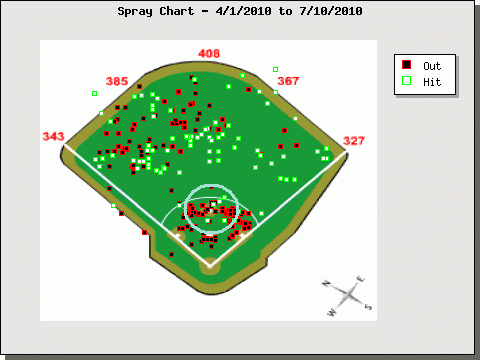In the first-half of the season, Joe Mauer turned in numbers
that were unbecoming of a reigning MVP. He still maintained an above average
walk rate and continued to spit out line drives out like sunflower seed shells
however, the numbers just wouldn’t cooperate.
He checked into the All Star Break hitting .293/.368/.434 (792 OPS) – slashes that were significantly
below his career norms coming into the season. Since his low point (one which
would be the majority of player’s career years), Mauer’s been wildly successful
in the season’s second act. From July 15th on, he is hitting
.442/.504/.681 (1.185 OPS) and has been a main catalyst in the team’s resurgence.
What has been the driving force behind this incredible hot
streak?
When the going was tough, various analysts and speculators
alike threw out plenty of explanations ranging
from lingering injuries to pitchers
changing their approach to positioning
of the defense that had adverse effects on Mauer’s overall totals. It
appears that all three played a partial role in his downsized totals, but it is
most likely that the last factor has been the most influential.
Some observers suggested that Mauer was no longer driving
the ball as well as he had in previous seasons, which was attributed to his
various physical ailments. Nevertheless, using the Inside Edge-collected Well-Hit Average, we
find that not only was he still hitting the ball with authority, he has been leading
the league in this scouted statistic this season. In fact, he has shown more
plate coverage than an episode of Man
v. Food:
|
Zone
|
Mauer’s Well-Hit Average
|
MLB Rank
|
League Average
|
|
Inside
|
.189
|
1st
|
.080
|
|
Middle (Vert)
|
.246
|
9th
|
.159
|
|
Outside
|
.251
|
1st
|
.095
|
|
Up
|
.243
|
1st
|
.103
|
|
Middle (Hor)
|
.269
|
2nd
|
.136
|
|
Down
|
.174
|
1st
|
.087
|
|
Overall
|
.395
|
1st
|
.214
|
(via MyInsideEdge.com)
With his long arms and sugar-sweet swing, Mauer has given
pitchers little areas of the strike zone to aim at without experiencing repercussions.
Regardless of what the pitcher decided to throw (fastball, changeup, slider,
kitchen sink, et al) and where, he was pasting pitches all around the field and
yet, for a substantial portion of the year, he did not reap the dividends of
doing so.
This is where the defensive alignment comes in.
As a hitter with a high percentage of ground balls, Mauer padded
his batting average by sneaking numerous bouncers through the infield in 2009. Last
year, he hit .288 on ground balls (65-for-226) while the rest of the league
floundered around the .230 mark. Mauer particularly thrived at muscling
grounders up the middle, hitting .632 on worm-burners in that direction (that’s
over 60% of total balls in play becoming hits). Visually, we find that his
spray charts reflect that the middle of the diamond was left unguarded last
season:
Opponents had figured out his tendency when it came to these
batted balls. Like most everything else, astute teams paid attention to this
detail and fortified the midsection of the infield a bit more thoroughly in
2010. Suddenly, that escape route for grounders was no longer a viable option:
As you can obtain from the spray chart above, numerous
would-be hits were thwarted near the keystone as teams shifted their shortstops
and second basemen to squeeze the middle. While still scorching ground balls,
Mauer did not get the same type of results he had the prior year. With this
option removed Mauer’s average on ground balls took a decisively raunchy turn
as the Twins catcher went 26-for-114 (.228
BABIP) on all grounders in the season’s first-half.
Perhaps partly due to the laws of regression and partly due
to his own adjustments to the defensive shading, Mauer’s ability to record hits
on grounders greatly improved. Assisting in raising that batting average back
above .330 is the fact that he is able to achieve hits by way of land once
again: Post-All Star Break, he is 19-for-48 (.395
BABIP) on ground balls.
To some extent, the same can be said about his line drive
figures as well. While he was buzzing liners around the field at a .781 BABIP
last year, a substantial number of those found their way to the awaiting defense
this season as teams positioned themselves to expect drives to left field.
Although opponents may shift the outfield around to accommodate for his
opposite-field line drive tendencies, his ability to hit the ball solidly to
all fields eventually resulted in clean hits which we have seen the past two
months.
While battling injuries and still hitting the cover off the
ball, Mauer had to solve the defense that continued to beat him in the
first-half of the season. His second-half has certainly been remarkable thus
far, but the Twins would benefit from an equally strong finish from their
franchise player to keep their stranglehold atop the AL Central.



